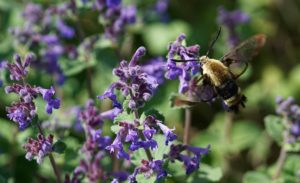Forget About Cats; Catmint is for Bees and Butterflies
Views: 4834

In my yard, after early spring bulbs and flowering shrubs, catmint is one of the first perennials to bloom. Along with dandelions and henbit, catmint is the big draw for bees, snowberry clearwing moths, and butterflies in late March and early April. Just this week, I saw two tiger swallowtail butterflies on one of my plants. In summer, I’ve seen hummingbirds on them.
Tough, easy-to-grow plants
Sometimes referred to by its genus, Nepeta, catmint is a tough plant in the mint family. Nepeta is native to Africa, Asia, and Europe, although it has naturalized in North America.
In my experience, most mints are pretty hardy, but catmint is extremely so. My plants survived nearly two months without water last summer, blooming cheerfully the entire time.
Catmints are great plants for beginning gardeners because they are typically drought tolerant, not terribly picky about soil, tolerate some shade, and are deer and rabbit resistant. Japanese catmint, Nepeta subsessilis, is an exception in that it prefers some shade and moister soil.
Catmint foliage is slightly fuzzy and green to silvery-green. Flower colors vary by variety, but range from white to deep lavender. Height and habit also vary, but many varieties are fairly compact. My plants are low and mounding.
Nepeta usually blooms from late spring to summer. My plants, obviously, start in early spring. Shearing will often ensure a second flush of flowers later in the season.

Snowberry clearwing moth on my Nepeta.
Varieties and cultivars
The most common catmint cultivars come from Faassen’s catmint, Nepeta x faassenii. This hybrid is sterile, so it doesn’t reseed or spread like some other catmints. Popular cultivars include “Cat’s Pajamas,” from Proven Winners, and “Walker’s Low,” named Perennial of the Year for 2007 by the Perennial Plant Association. I believe my plants are Walker’s Low.
Nepeta cataria, also known as catnip, has nepetalactone in its leaves. That’s the compound that makes cats a little loopy or euphoric when they get around it. So, while some people report their cats show some interest in other catmints, it’s typically not to the same degree as with catnip. Bees and butterflies, on the other hand….
Meet Leslie Miller
Leslie Ann Miller shares 3.5 acres in rural Oklahoma with birds, butterflies and wide variety of animals. She is currently transforming her yard with plantings…
Leslie's Recent Posts

Nandina Berries Are Potentially Harmful to Birds: A Warning






